Novel Hydroxamic Acids Containing Aryl-Substituted 1,2,4- or 1,3,4-Oxadiazole Backbones and an Investigation of Their Antibiotic Potentiation Activity
Abstract
:1. Introduction
2. Results and Discussion
2.1. Synthesis of Hydroxamic Acids Containing a 1,2,4-Oxadiazole Nucleus
2.2. Synthesis of Hydroxamic Acids Containing a 1,3,4-Oxadiazole Nucleus
2.3. In Vitro Studies of Potentiation of Antimicrobial Drugs via LpxC inhibitors
2.4. Cytotoxicity Assay
2.5. Computer Modeling of Active Compounds
2.5.1. Docking of Active Compounds to LpxC Structure
2.5.2. Pharmacophore Models of Active Compounds
2.5.3. QSAR Models of Active Compounds
3. Materials and Methods
3.1. Materials
3.2. Cell Culture
3.3. Generation of Growth Curves
3.4. Antibiotic Activity Evaluation
3.5. Cytotoxicity Assay
4. Conclusions
Supplementary Materials
Author Contributions
Funding
Institutional Review Board Statement
Informed Consent Statement
Data Availability Statement
Acknowledgments
Conflicts of Interest
References
- Niu, Z.; Lei, P.; Wang, Y.; Wang, J.; Yang, J.; Zhang, J. Small Molecule LpxC Inhibitors against Gram-Negative Bacteria: Advances and Future Perspectives. Eur. J. Med. Chem. 2023, 253, 115326. [Google Scholar] [CrossRef] [PubMed]
- Kalinin, D.V.; Holl, R. LpxC Inhibitors: A Patent Review (2010–2016). Expert Opin. Ther. Pat. 2017, 27, 1227–1250. [Google Scholar] [CrossRef] [PubMed]
- Frackenpohl, J.; Schneider, L.; Decker, L.J.B.; Dittgen, J.; Fenkl, F.; Fischer, C.; Franke, J.; Freigang, J.; Getachew, R.; Gonzalez Fernandez-Nino, S.M.; et al. Identifying New Lead Structures to Enhance Tolerance towards Drought Stress via High-Throughput Screening Giving Crops a Quantum of Solace. Bioorg. Med. Chem. 2019, 27, 115142. [Google Scholar] [CrossRef] [PubMed]
- Perman, S.M.; Goyal, M.; Gaieski, D.F. Initial Emergency Department Diagnosis and Management of Adult Patients with Severe Sepsis and Septic Shock. Scand. J. Trauma Resusc. Emerg. Med. 2012, 20, 41. [Google Scholar] [CrossRef] [PubMed]
- Negash, K.H.; Norris, J.K.S.; Hodgkinson, J.T. Siderophore–Antibiotic Conjugate Design: New Drugs for Bad Bugs? Molecules 2019, 24, 3314. [Google Scholar] [CrossRef]
- Chernyshov, V.V.; Kuzovlev, A.S.; Cherepanova, N.D.; Kasatkina, M.A.; Ivanov, R.A. Siderophore-antibiotic Conjugates: Structural Diversity and Antibacterial Activity. Clin. Microbiol. Antimicrob. Chemother. 2022, 24, 314–344. [Google Scholar] [CrossRef]
- Durand, G.A.; Raoult, D.; Dubourg, G. Antibiotic Discovery: History, Methods and Perspectives. Int. J. Antimicrob. Agents 2019, 53, 371–382. [Google Scholar] [CrossRef]
- Baym, M.; Stone, L.K.; Kishony, R. Multidrug Evolutionary Strategies to Reverse Antibiotic Resistance. Science 2016, 351, aad3292. [Google Scholar] [CrossRef]
- Cal, P.M.S.D.; Matos, M.J.; Bernardes, G.J.L. Trends in Therapeutic Drug Conjugates for Bacterial Diseases: A Patent Review. Expert Opin. Ther. Pat. 2017, 27, 179–189. [Google Scholar] [CrossRef]
- Skwarczynski, M.; Bashiri, S.; Yuan, Y.; Ziora, Z.M.; Nabil, O.; Masuda, K.; Khongkow, M.; Rimsueb, N.; Cabral, H.; Ruktanonchai, U.; et al. Antimicrobial Activity Enhancers: Towards Smart Delivery of Antimicrobial Agents. Antibiotics 2022, 11, 412. [Google Scholar] [CrossRef]
- Chawla, M.; Verma, J.; Gupta, R.; Das, B. Antibiotic Potentiators Against Multidrug-Resistant Bacteria: Discovery, Development, and Clinical Relevance. Front. Microbiol. 2022, 13, 887251. [Google Scholar] [CrossRef] [PubMed]
- Tamma, P.D.; Cosgrove, S.E.; Maragakis, L.L. Combination Therapy for Treatment of Infections with Gram-Negative Bacteria. Clin. Microbiol. Rev. 2012, 25, 450–470. [Google Scholar] [CrossRef] [PubMed]
- Barb, A.W.; Jiang, L.; Raetz, C.R.H.; Zhou, P. Structure of the Deacetylase LpxC Bound to the Antibiotic CHIR-090: Time-Dependent Inhibition and Specificity in Ligand Binding. Proc. Natl. Acad. Sci. USA 2007, 104, 18433–18438. [Google Scholar] [CrossRef] [PubMed]
- Lemaître, N.; Liang, X.; Najeeb, J.; Lee, C.-J.; Titecat, M.; Leteurtre, E.; Simonet, M.; Toone, E.J.; Zhou, P.; Sebbane, F. Curative Treatment of Severe Gram-Negative Bacterial Infections by a New Class of Antibiotics Targeting LpxC. MBio 2017, 8, e00674-17. [Google Scholar] [CrossRef] [PubMed]
- Candelli, M.; Franza, L.; Pignataro, G.; Ojetti, V.; Covino, M.; Piccioni, A.; Gasbarrini, A.; Franceschi, F. Interaction between Lipopolysaccharide and Gut Microbiota in Inflammatory Bowel Diseases. Int. J. Mol. Sci. 2021, 22, 6242. [Google Scholar] [CrossRef] [PubMed]
- Pirrung, M.C.; Tumey, L.N.; McClerren, A.L.; Raetz, C.R.H. High-Throughput Catch-and-Release Synthesis of Oxazoline Hydroxamates. Structure-Activity Relationships in Novel Inhibitors of Escherichia coli LpxC: In Vitro Enzyme Inhibition and Antibacterial Properties. J. Am. Chem. Soc. 2003, 125, 1575–1586. [Google Scholar] [CrossRef] [PubMed]
- Shen, S.; Kozikowski, A.P. Why Hydroxamates May Not Be the Best Histone Deacetylase Inhibitors—What Some May Have Forgotten or Would Rather Forget? ChemMedChem 2016, 11, 15–21. [Google Scholar] [CrossRef]
- Jackman, J.E.; Fierke, C.A.; Tumey, L.N.; Pirrung, M.; Uchiyama, T.; Tahir, S.H.; Hindsgaul, O.; Raetz, C.R.H. Antibacterial Agents That Target Lipid A Biosynthesis in Gram-Negative Bacteria. Inhibition of Diverse UDP-3-O-(R-3-Hydroxymyristoyl)-N-Acetylglucosamine Deacetylases by Substrate Analogs Containing Zinc Binding Motifs. J. Biol. Chem. 2000, 275, 11002–11009. [Google Scholar] [CrossRef]
- Barb, A.W.; Leavy, T.M.; Robins, L.I.; Guan, Z.; Six, D.A.; Zhou, P.; Bertozzi, C.R.; Raetz, C.R.H. Uridine-Based Inhibitors as New Leads for Antibiotics Targeting Escherichia coli LpxC. Biochemistry 2009, 48, 3068–3077. [Google Scholar] [CrossRef]
- Furuya, T.; Shapiro, A.B.; Comita-Prevoir, J.; Kuenstner, E.J.; Zhang, J.; Ribe, S.D.; Chen, A.; Hines, D.; Moussa, S.H.; Carter, N.M.; et al. N-Hydroxyformamide LpxC Inhibitors, Their In Vivo Efficacy in a Mouse Escherichia coli Infection Model, and Their Safety in a Rat Hemodynamic Assay. Bioorg. Med. Chem. 2020, 28, 115826. [Google Scholar] [CrossRef]
- Shin, H.; Gennadios, H.A.; Whittington, D.A.; Christianson, D.W. Amphipathic Benzoic Acid Derivatives: Synthesis and Binding in the Hydrophobic Tunnel of the Zinc Deacetylase LpxC. Bioorg. Med. Chem. 2007, 15, 2617–2623. [Google Scholar] [CrossRef] [PubMed]
- Pirrung, M.C.; Tumey, L.N.; Raetz, C.R.H.; Jackman, J.E.; Snehalatha, K.; McClerren, A.L.; Fierke, C.A.; Gantt, S.L.; Rusche, K.M. Inhibition of the Antibacterial Target UDP-(3-O-Acyl)-N-Acetylglucosamine Deacetylase (LpxC): Isoxazoline Zinc Amidase Inhibitors Bearing Diverse Metal Binding Groups. J. Med. Chem. 2002, 45, 4359–4370. [Google Scholar] [CrossRef] [PubMed]
- Chen, M.-H.; Steiner, M.G.; de Laszlo, S.E.; Patchett, A.A.; Anderson, M.S.; Hyland, S.A.; Russell Onishi, H.; Silyer, L.L.; Raetz, C.R.H. Carbohydroxamido-Oxazolidines: Antibacterial Agents That Target Lipid A Biosynthesis. Bioorg. Med. Chem. Lett. 1999, 9, 313–318. [Google Scholar] [CrossRef] [PubMed]
- Onishi, H.R.; Pelak, B.A.; Gerckens, L.S.; Silver, L.L.; Kahan, F.M.; Chen, M.-H.; Patchett, A.A.; Galloway, S.M.; Hyland, S.A.; Anderson, M.S.; et al. Antibacterial Agents That Inhibit Lipid A Biosynthesis. Science 1996, 274, 980–982. [Google Scholar] [CrossRef] [PubMed]
- Kline, T.; Andersen, N.H.; Harwood, E.A.; Bowman, J.; Malanda, A.; Endsley, S.; Erwin, A.L.; Doyle, M.; Fong, S.; Harris, A.L.; et al. Potent, Novel in Vitro Inhibitors of the Pseudomonas aeruginosa Deacetylase LpxC. J. Med. Chem. 2002, 45, 3112–3129. [Google Scholar] [CrossRef] [PubMed]
- Lee, C.-J.; Liang, X.; Gopalaswamy, R.; Najeeb, J.; Ark, E.D.; Toone, E.J.; Zhou, P. Structural Basis of the Promiscuous Inhibitor Susceptibility of Escherichia coli LpxC. ACS Chem. Biol. 2014, 9, 237–246. [Google Scholar] [CrossRef] [PubMed]
- Parikh, P.H.; Timaniya, J.B.; Patel, M.J.; Patel, K.P. Design, Synthesis, and Characterization of Novel Substituted 1,2,4-Oxadiazole and Their Biological Broadcast. Med. Chem. Res. 2020, 29, 538–548. [Google Scholar] [CrossRef]
- Karabanovich, G.; Zemanová, J.; Smutný, T.; Székely, R.; Šarkan, M.; Centárová, I.; Vocat, A.; Pávková, I.; Čonka, P.; Němeček, J.; et al. Development of 3,5-Dinitrobenzylsulfanyl-1,3,4-Oxadiazoles and Thiadiazoles as Selective Antitubercular Agents Active Against Replicating and Nonreplicating Mycobacterium tuberculosis. J. Med. Chem. 2016, 59, 2362–2380. [Google Scholar] [CrossRef]
- Chernyshov, V.V.; Yarovaya, O.I.; Esaulkova, I.L.; Sinegubova, E.; Borisevich, S.S.; Popadyuk, I.I.; Zarubaev, V.V.; Salakhutdinov, N.F. Novel O-Acylated Amidoximes and Substituted 1,2,4-Oxadiazoles Synthesised from (+)-Ketopinic Acid Possessing Potent Virus-Inhibiting Activity against Phylogenetically Distinct Influenza A Viruses. Bioorg. Med. Chem. Lett. 2022, 55, 128465. [Google Scholar] [CrossRef]
- Gonda, T.; Bérdi, P.; Zupkó, I.; Fülöp, F.; Szakonyi, Z. Stereoselective Synthesis, Synthetic and Pharmacological Application of Monoterpene-Based 1,2,4- and 1,3,4-Oxadiazoles. Int. J. Mol. Sci. 2017, 19, 81. [Google Scholar] [CrossRef]
- Vaidya, A.; Jain, S.; Jain, P.; Jain, P.; Tiwari, N.; Jain, R.; Jain, R.; Jain, K.A.; Agrawal, K.R. Synthesis and Biological Activities of Oxadiazole Derivatives: A Review. Mini-Rev. Med. Chem. 2016, 16, 825–845. [Google Scholar] [CrossRef] [PubMed]
- Markov, A.V.; Sen’kova, A.V.; Popadyuk, I.I.; Salomatina, O.V.; Logashenko, E.B.; Komarova, N.I.; Ilyina, A.A.; Salakhutdinov, N.F.; Zenkova, M.A. Novel 3′-Substituted-1′,2′,4′-Oxadiazole Derivatives of 18βh-Glycyrrhetinic Acid and Their O-Acylated Amidoximes: Synthesis and Evaluation of Antitumor and Anti-Inflammatory Potential In Vitro and In Vivo. Int. J. Mol. Sci. 2020, 21, 3511. [Google Scholar] [CrossRef] [PubMed]
- Salahuddin; Mazumder, A.; Yar, M.S.; Mazumder, R.; Chakraborthy, G.S.; Ahsan, M.J.; Rahman, M.U. Updates on Synthesis and Biological Activities of 1,3,4-Oxadiazole: A Review. Synth. Commun. 2017, 47, 1805–1847. [Google Scholar] [CrossRef]
- Dhameliya, T.M.; Chudasma, S.J.; Patel, T.M.; Dave, B.P. A Review on Synthetic Account of 1,2,4-Oxadiazoles as Anti-Infective Agents. Mol. Divers. 2022, 26, 2967–2980. [Google Scholar] [CrossRef] [PubMed]
- Hendawy, O.M. A Comprehensive Review of Recent Advances in the Biological Activities of 1,2,4-Oxadiazoles. Arch. Pharm. 2022, 355, 2200045. [Google Scholar] [CrossRef]
- Kumar, N.; Ghosh, S.; Bhunia, S.; Bisai, A. Synthesis of 2-Oxindoles via “transition-Metal-Free” Intramolecular Dehydrogenative Coupling (IDC) of sp2 C-H and sp3 C-H Bonds. Beilstein J. Org. Chem. 2016, 12, 1153–1169. [Google Scholar] [CrossRef]
- Gangloff, A.R.; Litvak, J.; Shelton, E.J.; Sperandio, D.; Wang, V.R.; Rice, K.D. Synthesis of 3,5-Disubstituted-1,2,4-Oxadiazoles Using Tetrabutylammonium Fluoride as a Mild and Efficient Catalyst. Tetrahedron Lett. 2001, 42, 1441–1443. [Google Scholar] [CrossRef]
- Yamada, T.; Shibata, Y.; Kawauchi, S.; Yoshizaki, S.; Tanaka, K. Formal Lossen Rearrangement/[3 + 2] Annulation Cascade Catalyzed by a Modified Cyclopentadienyl RhIII Complex. Chem. Eur. J. 2018, 24, 5723–5727. [Google Scholar] [CrossRef]
- Maciel, L.G.; Barbosa, A.D.S.; de Alencar-Filho, E.B.; Soares, T.A.; Dos Anjos, J.V. A Second Generation of 1,2,4-Oxadiazole Derivatives with Enhanced Solubility for Inhibition of 3-Hydroxykynurenine Transaminase (HKT) FromAedes Aegypti. RSC Med. Chem. 2021, 12, 222–236. [Google Scholar] [CrossRef]
- Brahmayya, M.; Liu, F.S.; Suen, S.Y.; Huang, C.C.; Dai, S.A.; Guo, Y.S.; Chen, Y.F. A New and Efficient Method for the Synthesis of 2-N-(Aryl)-1,3,4-Oxadiazole-2,5-Diamine Derivatives. Res. Chem. Intermed. 2016, 42, 1965–1975. [Google Scholar] [CrossRef]
- Fenner, L.; Reid, S.E.; Fox, M.P.; Garone, D.; Wellington, M.; Prozesky, H.; Zwahlen, M.; Schomaker, M.; Wandeler, G.; Kancheya, N.; et al. Tuberculosis and the Risk of Opportunistic Infections and Cancers in HIV-Infected Patients Starting ART in Southern Africa. Trop. Med. Int. Health 2013, 18, 194–198. [Google Scholar] [CrossRef] [PubMed]
- CLSI Document M7-A9; Methods for Dilution Antimicrobial Susceptibility Tests for Bacteria that Grow Aerobically (9th ed.). Clinical and Laboratory Standards Institute: Wayne, PA, USA, 2012.
- CLSI Document M100-A30; Performance Standards for Antimicrobial Susceptibility Testing (30th ed.). Clinical and Laboratory Standards Institute: Wayne, PA, USA, 2020.
- O’Brien, J.; Wilson, I.; Orton, T.; Pognan, F. Investigation of the Alamar Blue (Resazurin) Fluorescent Dye for the Assessment of Mammalian Cell Cytotoxicity. Eur. J. Biochem. 2000, 267, 5421–5426. [Google Scholar] [CrossRef]

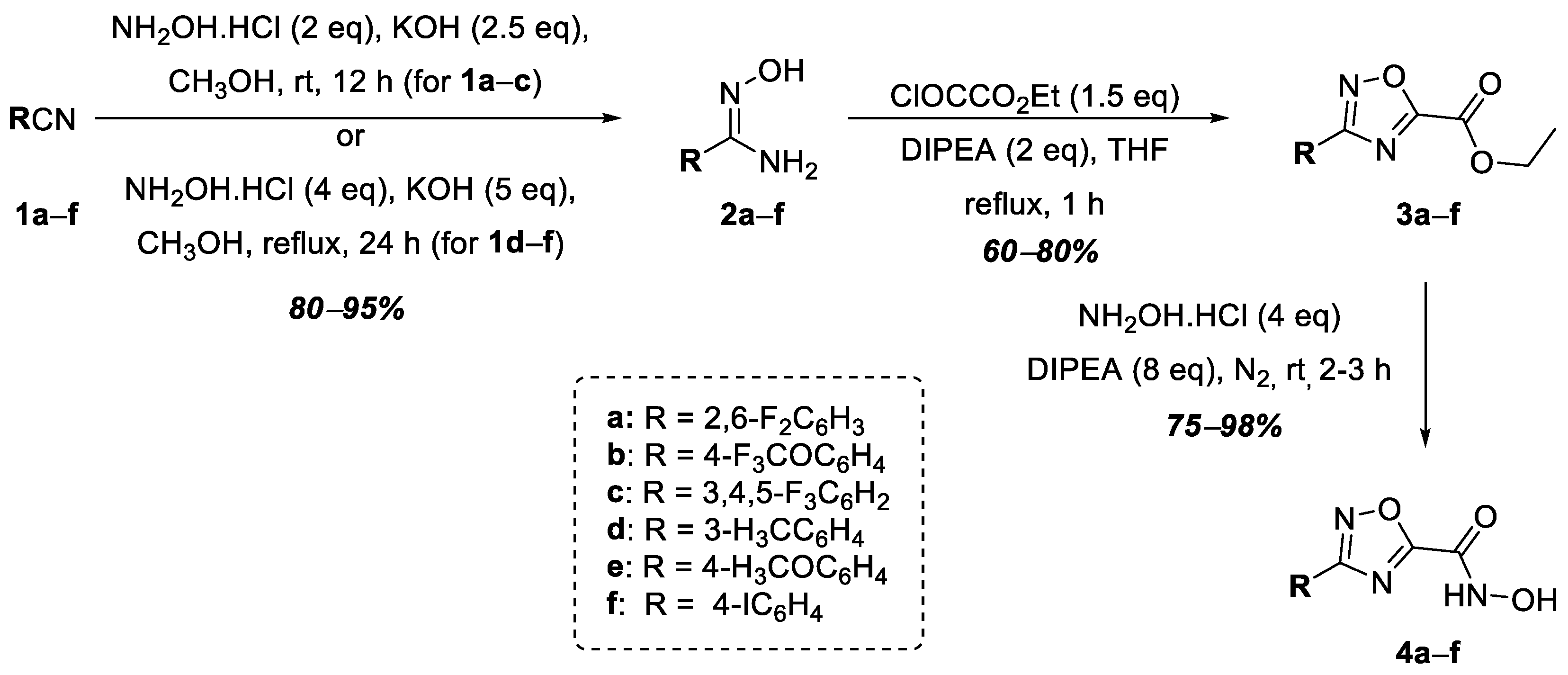

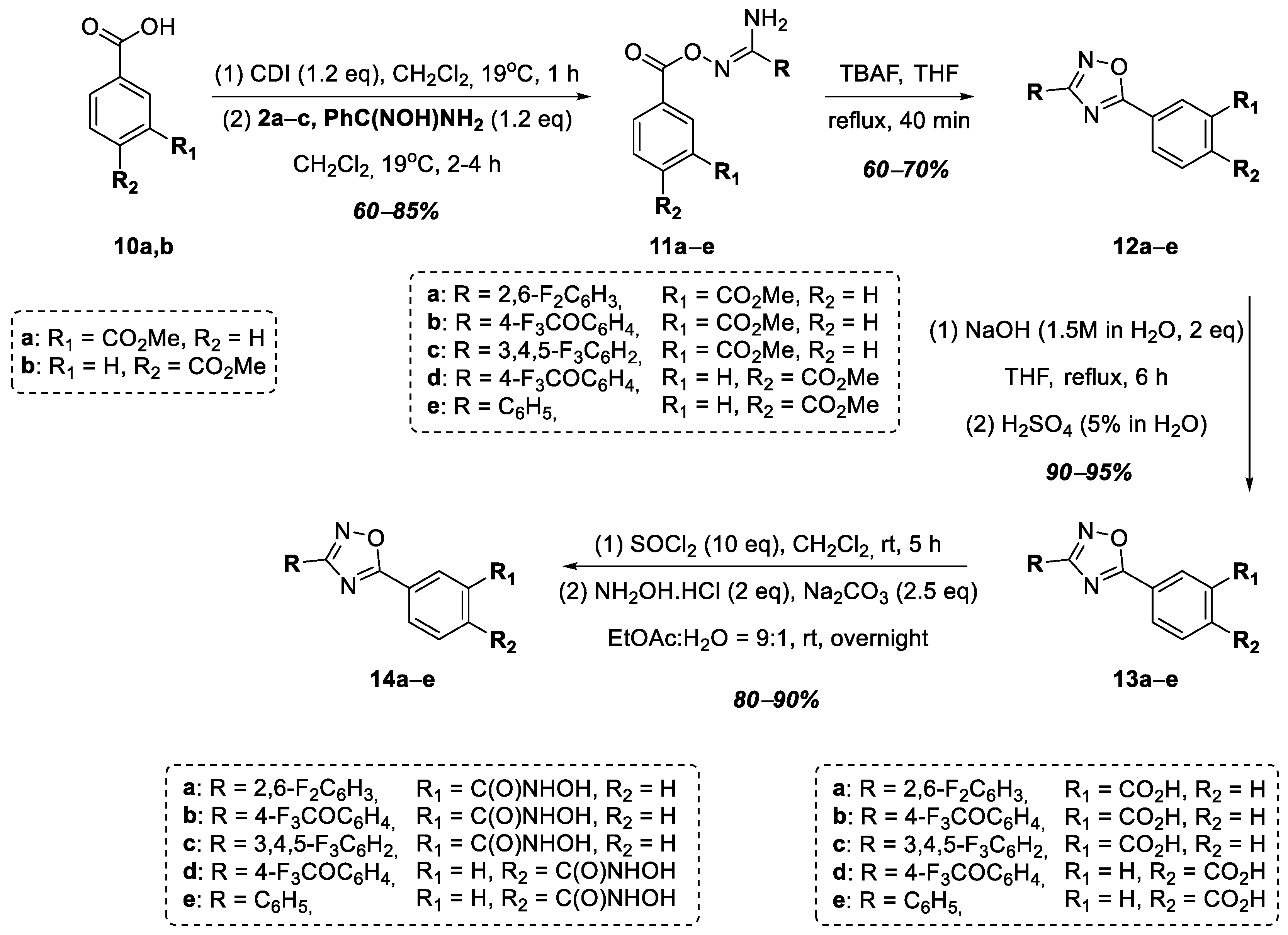

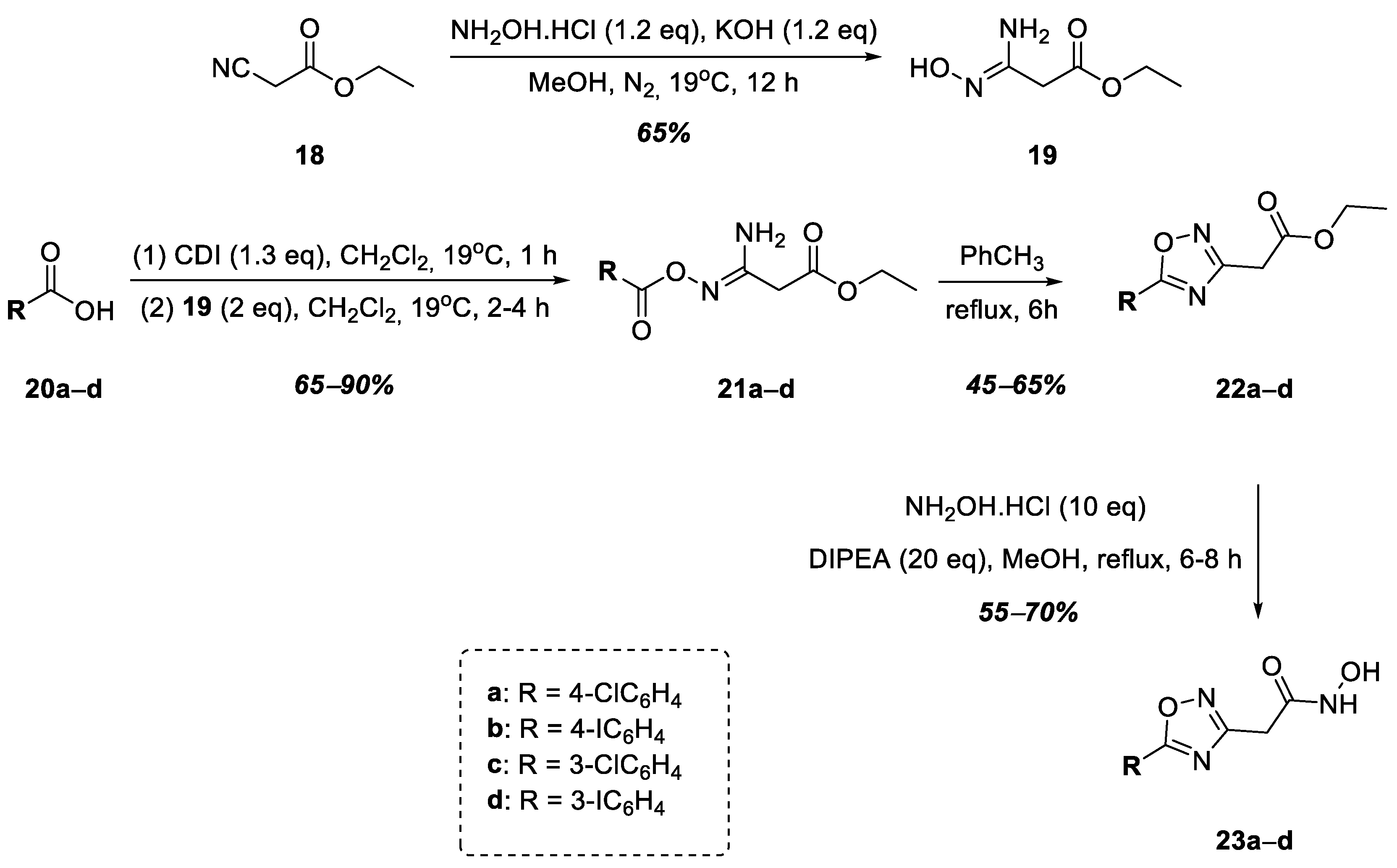
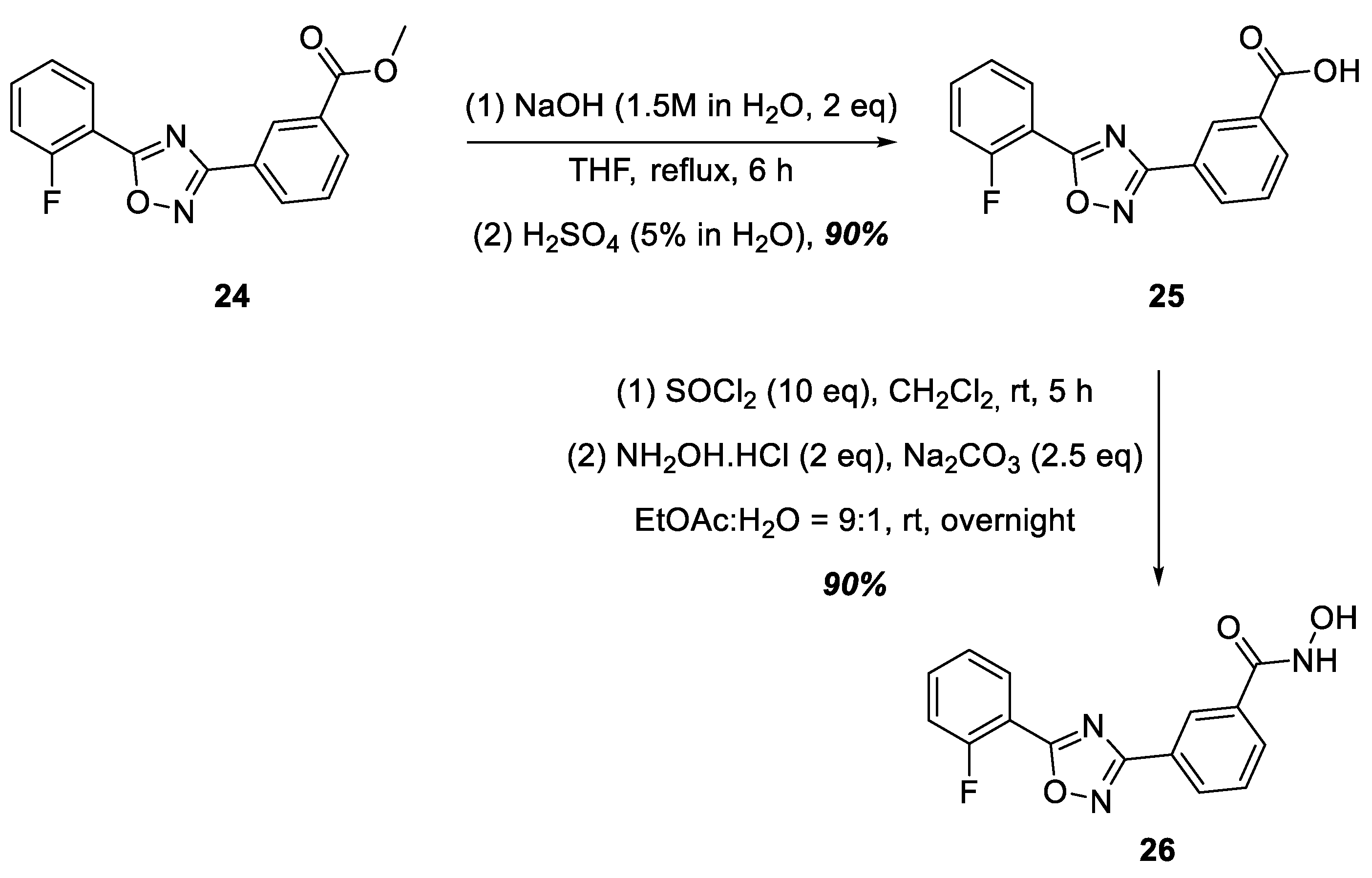


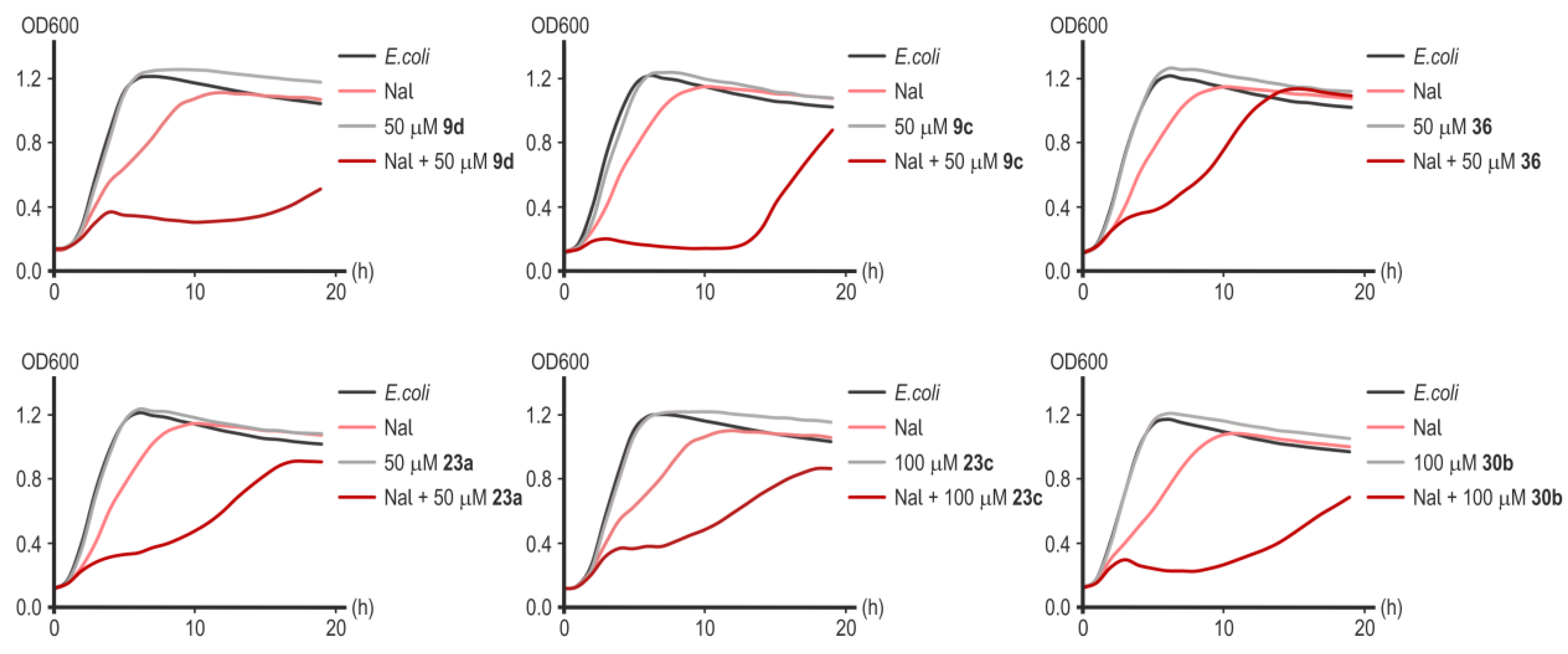


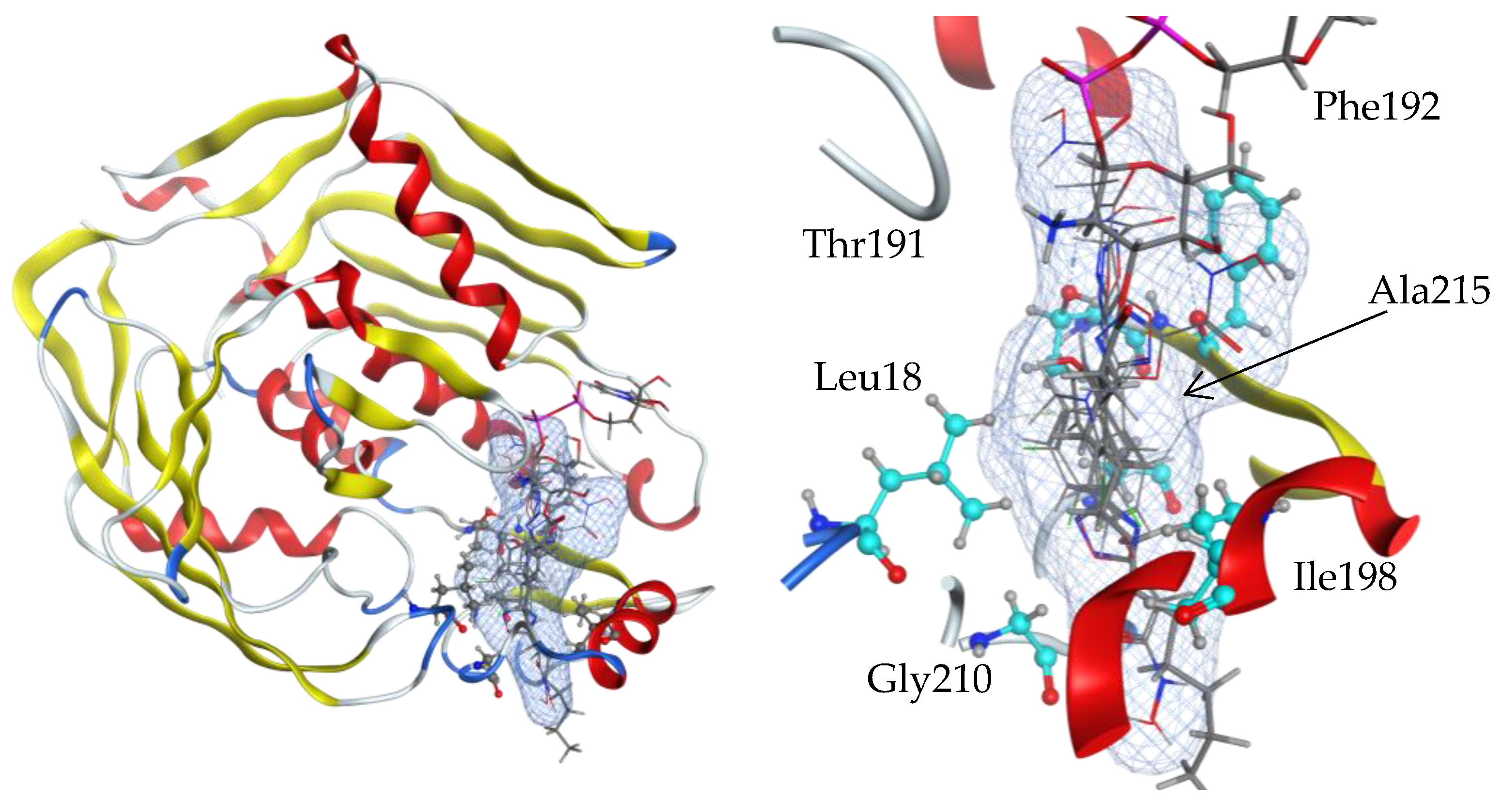
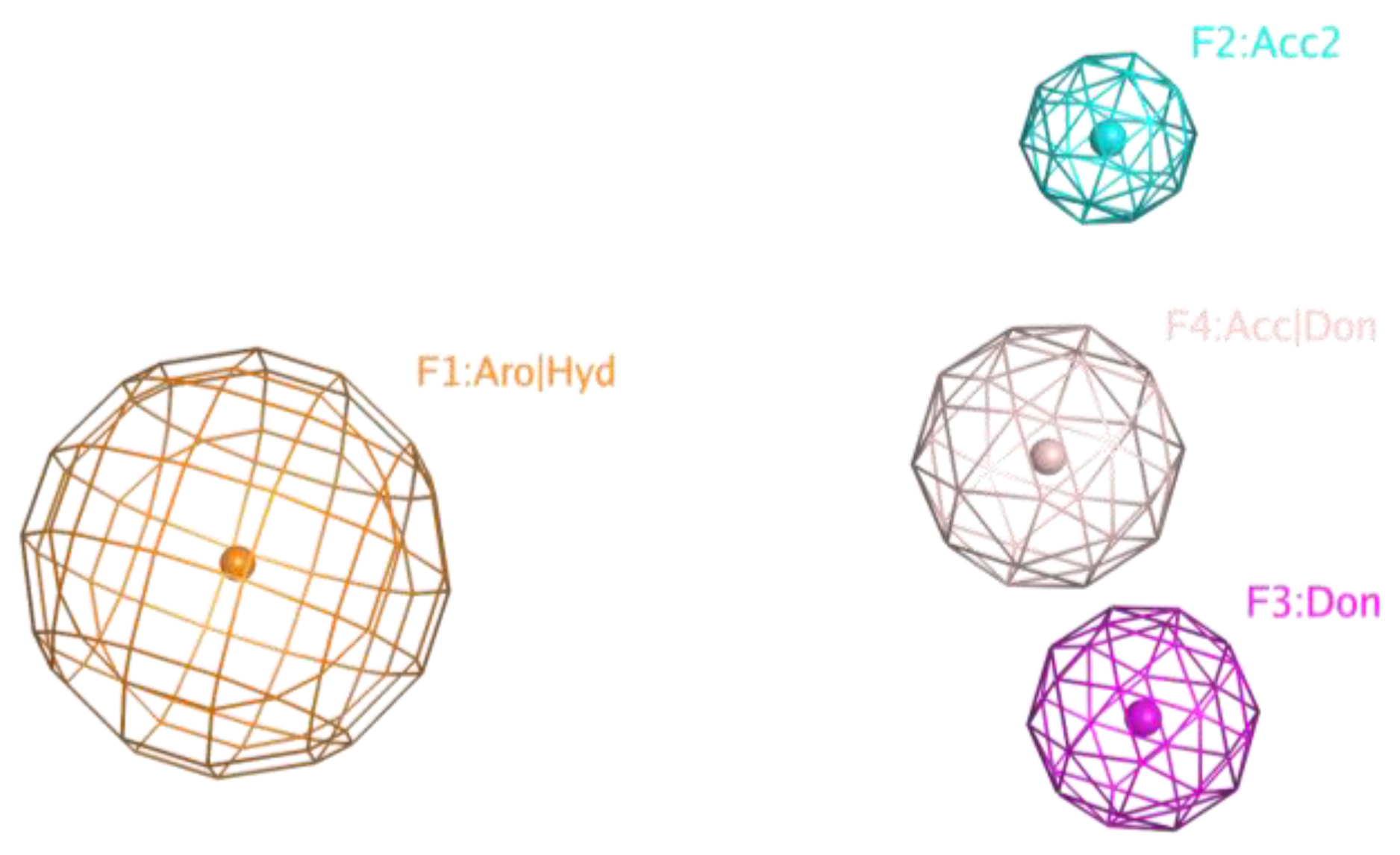
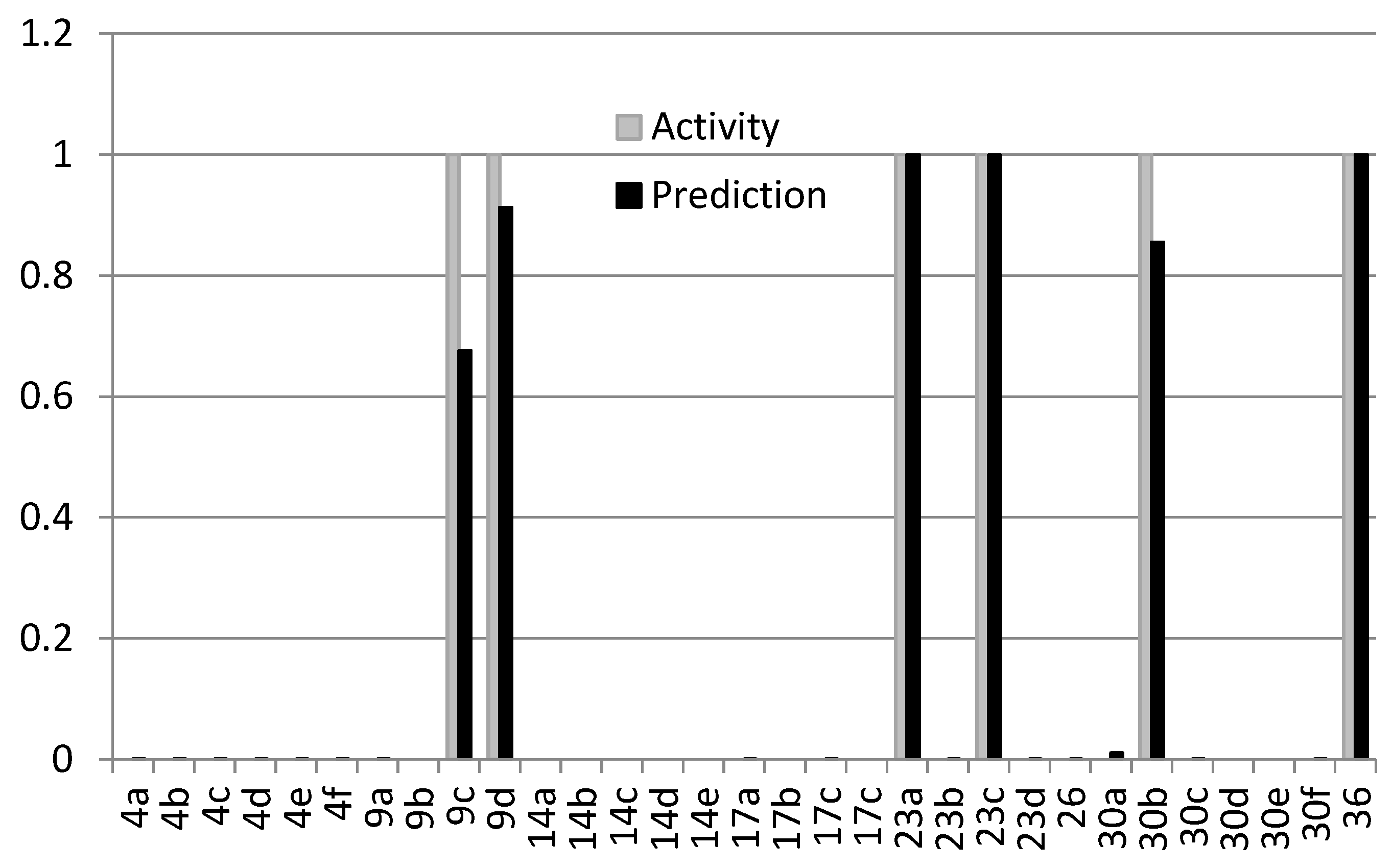
| Compound | CC50 2 (HEK293), μM | Compound | CC50 2 (HEK293), μM |
|---|---|---|---|
| 4a | >500 3 | 17a | 30.83 ± 3.71 |
| 4b | 380.20 ± 10.16 | 17b | 42.40 ± 4.58 |
| 4c | >500 3 | 17c | 59.22 ± 7.27 |
| 4d | 456.60 ± 18.15 | 17d | 21.30 ± 2.53 |
| 4e | >250 3 | 23a 4 | 112.50 ± 18.59 |
| 4f | 367.00 ± 53.94 | 23b | 168.80 ± 22.46 |
| 9a | 187.60 ± 31.24 | 23c 4 | 142.80 ± 3.84 |
| 9b | 108.10 ± 23.87 | 23d | 171.10 ± 22.86 |
| 9c4 | 188.60 ± 29.54 | 26 | 21.74 ± 3.43 |
| 9d4 | 176.30 ± 17.78 | 30a | 62.19 ± 9.88 |
| 14a | 25.54 ± 3.11 | 30b 4 | >200 3 |
| 14b | 6.39 ± 1.32 | 30c | >200 3 |
| 14c | 4.53 ± 1.22 | 30d | >600 3 |
| 14d | 5.28 ± 1.05 | 30e | 770.50 ± 58.37 |
| 14e | 15.00 ± 0.53 | 30f | 478.30 ± 50.48 |
| 36 4 | 131.80 ± 23.70 |
Disclaimer/Publisher’s Note: The statements, opinions and data contained in all publications are solely those of the individual author(s) and contributor(s) and not of MDPI and/or the editor(s). MDPI and/or the editor(s) disclaim responsibility for any injury to people or property resulting from any ideas, methods, instructions or products referred to in the content. |
© 2023 by the authors. Licensee MDPI, Basel, Switzerland. This article is an open access article distributed under the terms and conditions of the Creative Commons Attribution (CC BY) license (https://creativecommons.org/licenses/by/4.0/).
Share and Cite
Zhukovets, A.A.; Chernyshov, V.V.; Al’mukhametov, A.Z.; Seregina, T.A.; Revtovich, S.V.; Kasatkina, M.A.; Isakova, Y.E.; Kulikova, V.V.; Morozova, E.A.; Cherkasova, A.I.; et al. Novel Hydroxamic Acids Containing Aryl-Substituted 1,2,4- or 1,3,4-Oxadiazole Backbones and an Investigation of Their Antibiotic Potentiation Activity. Int. J. Mol. Sci. 2024, 25, 96. https://doi.org/10.3390/ijms25010096
Zhukovets AA, Chernyshov VV, Al’mukhametov AZ, Seregina TA, Revtovich SV, Kasatkina MA, Isakova YE, Kulikova VV, Morozova EA, Cherkasova AI, et al. Novel Hydroxamic Acids Containing Aryl-Substituted 1,2,4- or 1,3,4-Oxadiazole Backbones and an Investigation of Their Antibiotic Potentiation Activity. International Journal of Molecular Sciences. 2024; 25(1):96. https://doi.org/10.3390/ijms25010096
Chicago/Turabian StyleZhukovets, Anastasia A., Vladimir V. Chernyshov, Aidar Z. Al’mukhametov, Tatiana A. Seregina, Svetlana V. Revtovich, Mariia A. Kasatkina, Yulia E. Isakova, Vitalia V. Kulikova, Elena A. Morozova, Anastasia I. Cherkasova, and et al. 2024. "Novel Hydroxamic Acids Containing Aryl-Substituted 1,2,4- or 1,3,4-Oxadiazole Backbones and an Investigation of Their Antibiotic Potentiation Activity" International Journal of Molecular Sciences 25, no. 1: 96. https://doi.org/10.3390/ijms25010096
APA StyleZhukovets, A. A., Chernyshov, V. V., Al’mukhametov, A. Z., Seregina, T. A., Revtovich, S. V., Kasatkina, M. A., Isakova, Y. E., Kulikova, V. V., Morozova, E. A., Cherkasova, A. I., Mannanov, T. A., Anashkina, A. A., Solyev, P. N., Mitkevich, V. A., & Ivanov, R. A. (2024). Novel Hydroxamic Acids Containing Aryl-Substituted 1,2,4- or 1,3,4-Oxadiazole Backbones and an Investigation of Their Antibiotic Potentiation Activity. International Journal of Molecular Sciences, 25(1), 96. https://doi.org/10.3390/ijms25010096








